The first steps on the continent were taken very carefully. It was an ice runway after all. Moving slowly in shuffling steps towards the snowy, less slippery area. Only then it felt like an safe arrival in Antarctica. (Or, for the most part, somewhere quite a bit above Antarctica. I only realized later that it took more than a week until I really stood on Antarctic soil.)
Time for some pictures of the plane and the group emerging from it.
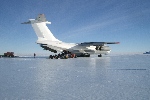
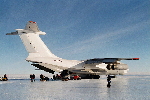
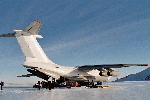
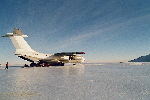
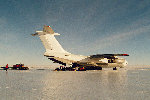
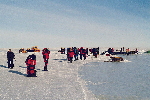
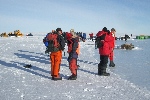
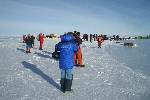
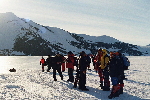
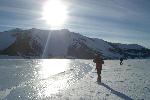
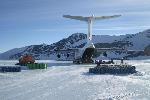

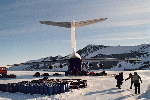
Time to head for the Patriot Hills camp.
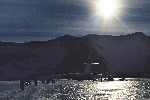
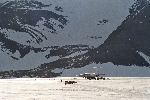
At the camp, we were split in two groups. (Well, essentially three groups, since there were also three Chilean scientists on the plane, who had their own living quarters at patriot hills.) The climbers had to set up their own mountaineering tents and live in those, while the 'Last Degree' and 'South Pole' people got 'weather haven' tents assigned. (The reason for this is simple. 'South Pole' and 'Last Degree' are organized directly by ANI, so we got to use the ANI facilities. The Mt.Vinson climbers do not book directly with ANI, but with various climbing organizations, which in turn use the logistics provided by ALE (Antarctic Logistics and Expeditions), which is now the parent company of ANI. So climbers use their own tents and use a separate 'main tent' for meals and so on, so they sort of live in a self-contained world of their own, until they leave for Mt.Vinson.) Typically there were two people to a fairly large sturdy, double walled tent, named after some polar explorer. I shared mine, named 'Henson', after Matthew Henson, with a former reporter from New York, who now works at an career agency for news people.
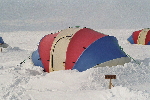
By now, the Ilyushin was almost ready to leave (it was now about 2 am). It often does a fly-over of the camp, so most of us new arrivals went to the 'hangar' to watch it leave.
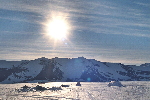
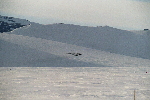
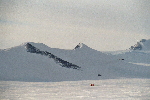
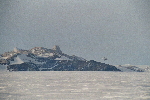
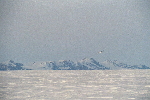
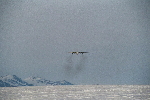
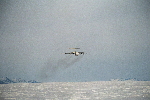
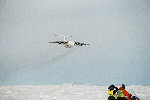
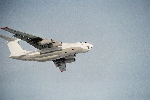
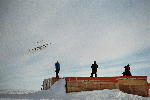
And with the last, well only, link with the rest of the world gone, it was time to go to the tent, unpack and get some sleep.
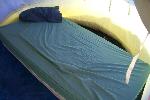
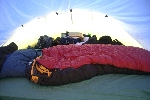
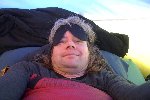
Since we had arrived rather late in the day (arrival was around midnight and I got to bed, well sleeping bag, about 2 am), breakfast was later than usual on the first day. After that, we had a short tour of the camp. Time for a couple of remarks about the camp. In the center of the camp were the radio and weather tent, easily recognizable by still being bright orange and connected to lots of antennas. Close to it, in a faded colour that might have been yellow or orange a couple of seasons ago, with a horizontal white stripe, was the staff meeting tent. The main structures to the sides of this 'central plaza', were two long, blue and white semi-cylindrical tents, which were kitchen, dining room, living room, lecture room, battery recharging room, warm temperature storage for equipment, info center and, most important for computer science people like me, the place to get coffee. 24 hours a day. In essence, these tents are the social center of the camp. (Well, actually just one tent. As mentioned before, the ANI clients used one, the climbers the corresponding tent on the other side.)
Then there were two smaller of the semi-cylindrical tents, easily recognizable by having two doors each, which contained the toilet facilities. Within the camp were two more of the semi-cylindrical 'polar haven' tents. One was the red-white medical tent, the other one was the entrance to the underground (under-ice? sub-glacial?) storage room, the ice-cave.
Add two small containers used by the Chilean scientists and that's the list of the 'big' buildings in the camp. Add about a dozen sleeping tents for the ANI clients, another dozen or so (mostly) mountaineering tents for the ANI employees (well, there were also two or three 'Scott' tents, which are of the 'pointy cone' type) and another dozen of mountaineering tents for the mountaineers and three Twin Otter planes, and that was the complete camp.

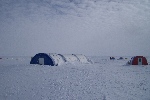
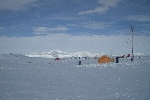
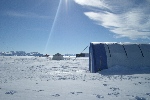
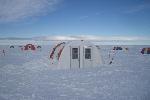

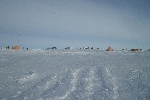
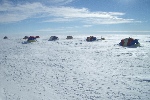
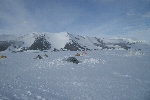
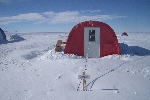
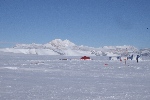
There was one other significant structure about half a kilometer towards the blue ice runway, which is the 'hangar'. It's mainly built from the remains of packing crates (at least it looks that way) and houses an old Cessna 185, which dates back to the early years of ANI. While the Twin Otters are in Antarctica only during the summer and go back to Canada by the end of the season, the Cessna (named 'Polar Pumpkin') stays in Antarctica. In fact, it now stays in the hangar all the time. It's not really useful anymore, so it is more a piece of polar history that is kept around than something that is still needed. Nice plane, though.
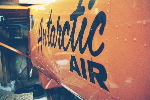
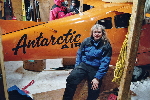
Time for a quick photo shoot around the hangar. As usual, I'm not quite appropriately dressed for the occasion.
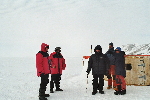
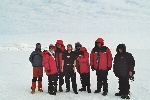
The next trip (I think that was after lunch that day), was to the unused Chilean station about a kilometer or so to the south-west. It was fairly large, since it was originally planned to provide the means for wintering, though it was never used for it, looked slightly futuristic (in a 70's kind of way), had been used the previous year and would probably be used again the next year. It was almost hidden by the snow and at the moment clearly unusable, since not all the sealed joints had remained sealed and in parts of the interior, the snow could be seen, thanks to the panoramic windows, to be about a meter high. (To give a feel for the spatial relationship: The tiny dots on the snow in the middle of the third picture are the Chilean camp as seen from the edge of the ANI Patriot Hills camp.) On question that I had been asking myself was: Why don't the Chilean scientists stay in the Chilean camp? I hadn't been really thinking about this, since the answer is fairly obvious: The fact that there was a Chilean camp there had nothing to do with this group of Chilean scientists and they had about as much a claim to the camp as I would have to using a spare room in the German embassy in Chile. Yes, it's German, yes, it's been paid for with taxpayer's money, but that doesn't give me any kinds of rights in using it. Just because it was a Chilean station didn't mean that someone from Chile could just go and live in it.
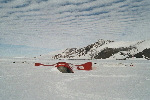
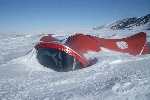
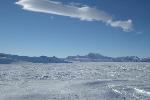
Later, at the camp, there was also a briefing on the conditions for the South Pole flight. To go to the South Pole from Patriot Hills, a number of criteria need to be fulfilled. Weather needs to be good enough at Patriot Hills to take off. Then there's a landing at Thiel Mountains at a fuel depot to refill the Twin Otter. So weather at Thiel Mountains needs to be fine. Also, weather at the Pole needs to be fine. Then, it still needs to be good at Thiel Mountains on the way back. And finally, it needs to be good enough for landing at Patriot Hills. So what is basically required is predictable fine weather for 15 hours at three points in the Antarctic. (About the timing: It takes about two hours to fly to Thiel Mountains, about an hour to refuel, another two hours to the South Pole, three hours at the Pole, and five hours back again. Add some delays and security margin and you're looking at 15 hours.) The key word is predictable. (Though it probably should be 'educated guess'.) It's no good to anyone if the weather looks fine at the moment, but gets all awkward ten hours later.
And information is very, very limited. Patriot Hills is reasonably easy, since it's local, so you can just look at the instruments and see what it's like and make decent guesses, based on the trends and experience. South Pole is also sort of ok, since they follow the weather closely on Amundsen-Scott Station and current conditions and forecasts are available a couple of times a day (I sort of recall three updates per day, but I may be mistaken). The critical point is Thiel Mountains, since there is (usually) nothing there. No weather station. No automatic anemometers. Nothing to measure visibility. Nothing at all, except a 'runway', which is a mostly flattened strip of snow, with a couple of snow filled garbage bags on its side to mark it and some fuel drums. So the only way to find out something about the conditions there are clouds on satellite images, which come in a couple of times a day, but with some long gaps in between, where the satellite is 'out of sight', so it's hardly continuous coverage. The only thing visible on these pictures are clouds, so the relevant information for making the flight (which is mostly wind speed and visibility on the ground) needs to be guessed, based on the movement of cloud patterns in the area, which may or may not coincide with the conditions on the ground.
Based on this information, Jaco, the weather guy at Patriot Hills, has to make the decision on whether the flight to the South Pole would be feasible. (As well as the flight for the climbers out to Mt.Vinson, which is slightly easier, since it's only about 180 km away, so overall weather conditions are reasonably close to Patriot Hills. And there are usually expeditions out there, who can give an "that's what it looks like right now" update.) [Btw, Jaco celebrated his birthday during the time when we were at the camp. Though I'm not going to go into detail about this. Or put pictures on the web. Some things just don't belong here.]
Currently, the conditions are not good. Patriot Hills is fairly windy, which would not be a problem as such, but South Pole Station is very windy, with low visibility and getting worse, while Thiel Mountains may be ok under a layer of clouds, but then again, may not be. We're clearly not flying today. And also not tomorrow. Mostly because of the weather at the South Pole, but also, because it's going to be New Year's Eve and the people at the Amundsen-Scott Station will nurse their hangovers... [Maybe a good time to mention time zones. Patriot Hills is on Chilean (summer) time, since that makes communication with Punta Arenas easier, while South Pole is on New Zealand time, since that makes communication with Christchurch easier for them. Which means that they are 14 hours ahead of us. If we leave Patriot Hills on the 31st of December at noon, and arrive at the South Pole five hours later, it's 7 am on New Year's Day for them, a time and date were we won't, even with the best intentions, be welcome. [Though this was a moot point anyway. On the last day of the year, weather conditions weren't good, so the South Pole runway was even closed to their own Hercules planes.]
No way to the pole yet. Good.
Good? I didn't realize it at the time, but sometime during that first day, I must have fallen in love with Antarctica. Badly.
Difficult to explain, but I never fell in love with people the way I fell in love with places.
I fell in love once with Greenland. And that was basically an intense, but short lived first love. But Antarctica just turned out to be the love of my life. If this sounds silly or pathetic, so be it. I'll probably feel ashamed of writing this in a couple of months, but right now it is true.
Ok, these are my web pages, so I'll make my own rules. Let's do it like this: Stuff that is sort of relevant, I'll keep in normal font. Stuff I write because I feel I have to write it, even though I know it's horribly pathetic, self-indulgent, vain and mostly far off from reality, I'll keep in italics. So you'll know which parts to skip and I can continue to write about things I feel the need to say, even knowing that I'll embarrass myself by saying this and it'll screw up the narrative. Just assume that the last three paragraphs should be written in italics.
Later that afternoon, I was getting restless. I enjoyed being 'out there' for the guided tours, and I didn't really feel like sitting around in the main tent or the sleeping tent and wait for dinner. Luckily, Fran (essentially 'The Organizer' - I'm tempted to call her 'Jack of all trades', but that sort of implies 'master of none', which, not only, I wouldn't dare to call her, but also everyone at ANI sort of did everything when required, so 'Jack of all trades' applies to everyone down there) had nothing to do that afternoon, so she agreed to have a late afternoon walk with me. (Which, now that I'm writing it down, seems silly to me. Describing Fran as having nothing to do at Patriot Hills in retrospect feels like describing ice at not being cold.) Anyway, Fran went walking with me along part of the Marathon track and then back along the Twin Otter runway.
Getting side-tracked for a moment: Patriot Hills has three runways - the blue ice runway for the Ilyushin, the snow runway for the ski-equipped Twin Otters and a Hercules runway for ski-equipped Hercules planes.
Did I mention that ski-equipped Hercules planes are not available outside the US government? Well, ANI (or ALE) has been in this business quite a while (it's their 20th anniversary this year, even though it's not their 20th season, since they didn't operate in the 2003/2004 season), and after playing nice for quite some time (which is sort of difficult to gleam from websites and books, where they are often vilified for some reason), they now actually provide some logistic for NSF (National Science Foundation) at Patriot Hills and get semi-regular visits from 'official US' Hercules planes (at least as far as 'regular' goes in the Antarctic, which is a contradiction in terms anyway).
Anyway, Fran took me on a tour slightly off-camp, for which I am grateful.
One things that often gets mentioned in Antarctic narratives is the intense silence.
Which does not exist.
But there is an intense feeling of silence, even if it is hard to hear in all the noise.
While this may sound contradictory, it is reasonably accurate. Being out of the camp for a kilometer or two made it even more obvious. Antarctica is a quiet place. Not only are there none of the noises of civilization you are accustomed to, the snow also 'eats' a lot of noise. (I was very surprised during the fly-over of the Ilyushin, when I couldn't hear the plane (which is a four engine jet airplane, not known for being particularly quiet) until it was right above us. The snow absorbs an awful lot of noise. But then again, the place is windy almost all the time and it keeps howling in your ears. Someone once wrote of the silence of lying in a field somewhere in the middle of nowhere being intensified be the sound of a single engine airplane somewhere in the distance. Antarctica is like that. It isn't quiet in any kind of measurable way. But it surely feels like it due to the absence of any known noises.
Looking at the web page, I can see that it has been a stretch of text without any pictures. So I should go on to the next day and have some more pictures, but for now I like to bring closure to the first day, and since I have been walking around without a camera, taking it all in (which is very, very untypical of me), I'll have to continue a bit until day two, which will include pictures again...
There was dinner in the evening. Very good dinner. Almost every web page or commentary mentioning ANI also mentions the surprising quality of the food. I'm not going to contradict this. Good foods makes good morale. The food was amazing. I'd probably go on about this at length, but I noticed I never noted the name of the Norwegian cook and I feel guilty not mentioning her, so let's just say "Thanks!" and go on to other things.
After dinner and sitting around and talking to people, I still wasn't ready to go to sleep. (Which probably isn't that unusual. After a couple of days, someone looked it me (might have been Fran, might have been Denise) and said "You can sleep when you get home, right?". Which strongly implied that I was starting to look a bit tired, but also that it was a condition that had been seen before.) Originally I wanted to go to the base of Patriot Hills for an evening walk, but I had to settle for another walk to the Chilean camp, which was closer. Nice way to spend three quarters of an hour, anyway.
(It was the first day in Antarctica and at that point I didn't realize that something that I learned in New Zealand over a month or so also applied in Antarctica: Rules are flexible. And "Don't do that!" often means: "This is not a good idea. Do it at your own risk. But if you're willing to do this, you're welcome." I really noticed on the last evening, when I went to the Chilean camp with Patrick. [Who was tired the first day and missed the original outing to that camp. On the last evening, before we left, I still wanted to keep moving and Patrick hadn't seen the Chilean camp yet, so I suggested to go there and I would be the tour guide (sort of). So I went to Fran and asked for permission and the reaction was sort of 'Why are you bothering me with that, go ahead, you know the way, don't you?" At that point I mentioned the rules I had to follow on the first outing (check out at the radio tent; take a two-way radio with you; notify someone at the radio tent know when you are back; don't move out of sight from the camp) and the answer was along the lines "That was your first day here, wasn't it?"] Not sure whether that was actually true, but I felt as if I had earned a little bit of trust and feeling of being reliable. Which was quite odd, since at this point I had sort of proven that I wasn't... But at least I was unreliable in a predictable way.)
Ok, it's been a long time without pictures, so I should skip to the next day.
Since we weren't going to the South Pole, we went to a crashed plane instead.
Back in 1993, a DC-6 belonging to Norman Vaughn's team (but not with Norman on board) crashed near Patriot Hills. On person was injured, but luckily not seriously. [You can read about this expedition in other sources, so I'm not going into too many details here. The basics are like this: Norman Vaughn was in Antarctica back in 1928 as a dog sledge driver. (Formally - as most expeditions go, it should probably read "dog sledge driver and everything else that might have been needed at the time", which still seems to hold true to this age. I didn't notice any of the ANI people to do just one job.) Since Byrd did see a lot of places that hadn't been seen before, he named a lot of them after people in his team. So there has been a Mt.Vaughn in Antarctica since 1928. After a fairly interesting life, Norman Vaughn planned to climb 'his' mountain on his 88th birthday in 1993. But the DC-6 he chartered did crash and he had to abandon his plan. Until the year after, when he went with ANI and managed to get on top of Mt.Vaughn on his 89th birthday. I don't have any 'idols' as a matter of principle. But I was very impressed by Norman Vaughn. (Side remark: He did try to get back to 'his' mountain on his 100th birthday, which was this season. Unfortunately, it didn't work out. Anyway, he would have flown back before I had arrived anyway, which is a good thing, since I probably would have been too tongue tied to talk to him anyway.)]
To get back to the point: The crashed DC-6 is about 8 km away from the Patriot Hills camp, so it was a bit too far for walking (though I wouldn't have really minded), so we took the Tucker to get there.
A Tucker is one of these strange polar vehicles and looks like this:
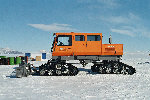
By now, the only thing left to see from the DC-6 is the tail fin.
Oddly enough (though not that oddly, based on the people I hang around with), one of the remarks someone gave me before going to Antarctica (actually two independent sources) was: "If you come across any strange flying objects in the ice do not try to dig them out." Luckily, everyone in the group had seen "The Thing" (in one of its incarnations), so we just took pictures next to the tail fin (and I'm sure I wasn't the only one humming the theme from "Jaws") and left the plane buried in snow. It's probably only going to be a tourist attraction for another season or two. After that, it'll be fully covered by snow.
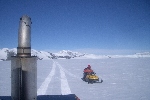
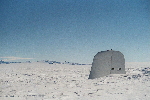
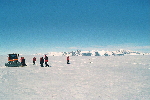
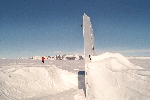
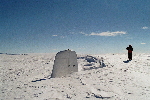
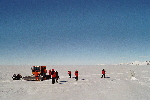
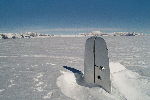
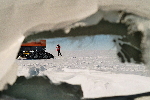

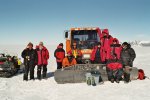
Well, this is a good point as any to identify a couple of names and persons, who may be mentioned on these web pages. If you take a look at the last picture, starting from the left, you'll see the driver of the Tucker (whose name I didn't write down - sorry). Next to him stands Connie (with the brown-white hat). Then there's a group of three, consisting of Andy (tour guide, black hat), Mike (medical assistant - he has some sort of formal title, but I forgot - red hat), Denise (tour guide and Antarctic goddess). On the right to the Tucker are me (black hat), Ezra (furry hat under the parka), Patrick (tall guy, video camera around his neck), Martin (sitting down - I can't recognize him, but it must have been him...) and Jacob's dad (I should have noted his name, [my notes say 'Ross', but that seems to be wrong] but somehow I didn't - anyway, his son went the Last Degree to the South Pole and he spent most of his time around camp, going to the interesting stuff later, after the rest of us left).
While I'm at listing people: There was also Cherry (who took the picture, so she isn't on it - she is a photographer, specialized on polar photography and the other Antarctic goddess and is on the left side of this picture), Fran (Organizer and 'person to talk to' - she's the one on the right side of this picture), John (the doctor - oddly enough it didn't even occur to me even once during the time in Antarctica to make a Mac Rebennack reference - he's the guy pouring whisky in this picture), and Steve (pilot, the guy with the orange cap in this picture). There were also Bob and Ian (geologists) and Mike Sharp (co-owner of ANI) (and a lot of other people), but more about them later.
The tourists, going to the pole, among the group are: Martin and Connie (from L.A.), Ezra (from New York), Patrick (from Ireland) and me.
We get back to the camp to have a last look at the Christmas decoration, before it was time to prepare for New Year.
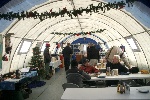

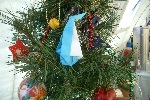
The cute origami penguins on the Christmas trees had been done by a couple of Japanese clients earlier in the season. Whoever you are: Thank You! Cool idea.
Then it was time for the three-course semi-formal New Year's Eve dinner. (Well, the tables were changed from the usual arrangement to a 'big dinner table arrangement'. Table cloth was used. Cutlery was laid out in advance. That's as formal as it gets in Patriot Hills. Good thing too, since I was wearing jeans and a t-shirt and couldn't have coped with anything more formal anyway...)

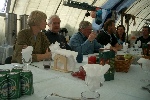
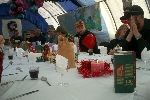
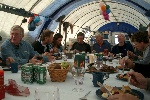
The dinner was followed by a round of Pisco Sour, which the quintessential Chilean style aperitif (well, supposedly it's originally from Peru, but as far as I could see, nobody in Chile cared about that at all). Actually it was more like a Pisco Bitter, based on the fact that Pisco Sour was usually too sweet anyway. While this looks strange written down, it made sense at the time and I'm not going to let common sense or semantics get between me and a drink at New Year's Eve...
That was followed by the 'fruit punch rescue'. While it may seem like a cool idea to carve a container for fruit bunch from ice, there is a certain drawback if the ice has cracks. You end up with a fruit salad on ice, with a lot of alcohol beneath. (Luckily someone did put it on some sort of baking tray in the first place, so it could be rescued.) After some coordinated lifting and repair work with saran-wrap, things looked reasonably impressive again. Nothing to build some group spirit than rescuing something to drink... Luckily I'm unlikely to ever get into the position of having to do 'team building', but if I ever have to do that, it's much less likely to involve crawling through mud, shooting paintballs and going through confidence courses than to 'rescue this drink'. There's a clear and obvious objective to that and somehow coordination just happens. But I digress.
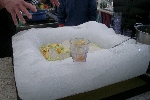
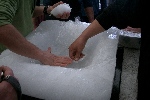
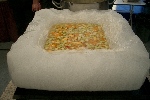
Rescuing the fruit punch was a complete success, so it was time for the next step: The Booze Luge.
Very simple to explain. You take a big chunk of ice. Someone who is reasonably sober (and this is the hard part as the evening continues) takes a chainsaw and cuts track in it. Someone holds the ice, someone puts some drink into the top of the track, and someone drinks the cooled drink at the bottom of the track. (Oh yes, and half a dozen people stand around and take pictures and videos...)
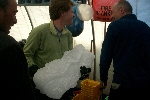
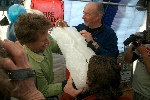
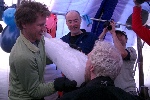
Later on the climbers from the other part of the camp are invited over and the party starts...
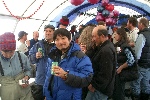
Even later you find yourself discussing the (lack of) attractions of Wuppertal with a group of Chilean scientists. (Don't ask.)
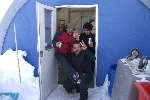
As a sort of "that's the way it was", that's me about 9 pm:

Probably around midnight:

Around 2 am:


And this is around 3 am - I obviously need some sleep:
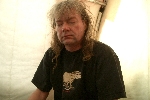
Btw, while it looks sort of daring to run around in a t-shirt at -5°C (23°F) it actually wasn't. It wasn't windy that night and the sun was shining, so it actually felt quite warm. While I probably couldn't have spent hours outside without ill effects, half an hour was quite ok and not uncomfortable, even early in the evening (later in the evening, alcohol may have had a little effect in ignoring the cold). I also committed a bit of a social blunder that night. While I was partying in jeans and t-shirt, some guy was wearing shorts and t-shirts. While usually "shorts under any conditions" is sort of a New Zealand 'tradition', I noticed on Fox glacier in New Zealand that the only people actually wearing shorts on a glacier were, in fact, from Australia. So I asked that guy whether my stereotypes matched reality or whether they were just stereotypes and whether he happened to be from Australia or New Zealand. He told me neither and I should try another guess. Told him, I couldn't think of one. The only one stupid enough to do something like that would be a drunk Scotsman. (Don't know why I thought that. Must have been a side-effect to being at Hogmanay 2000 in Edinburgh.) "Well," he said, "I had something to drink and I am Scotish." So after trying not to fall into stereotypes, I walked right into one...
Next day breakfast starts a little later than usual. And one of the great things about Antarctica is that it's very easy to find some ice in case of a hangover. Anyway, weather is fine at Patriot Hills. Nice start to the New Year. Hello 2006! The year of getting to the South Pole!

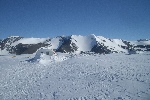
Slightly windy, but lots of blue skies. Weather is also fine at Mt.Vinson, so in the afternoon the climbers fly to the base camp there. It's getting sort of empty at Patriot Hills
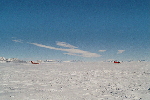
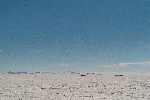
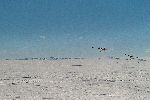
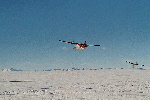
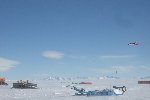
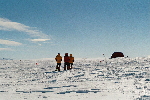
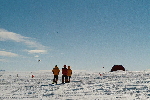
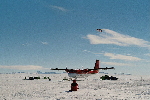
By now, only eight clients are left in the camp. Five of us going to the Pole, two going on the 'Last Degree' and one to go to the Pole later. And Cherry, the photographer, who is not employed directly by ANI, but has some sort of agreement where she takes pictures for ANI and gets around in Antarctica in exchange. And, quite noticeable, Cherry really likes polar conditions. I find myself being outside quite a lot. If there's lunch at 1 pm and everyone is finished around 2 pm, there's usually something planned for 3 pm, like a visit to the medical or radio tent, a presentation by one of the geologists or a guide or some sort of excursion. Most go back to their tents for the hour or stay in the main tent to read, write, talk or think. I'm going "great, I've got another hour in Antarctica", put on my warm gear (when it's windy) and just stand outside, at the edge of the camp and look over the (seemingly) endless plains or the hills for an hour. Usually, the only other person being outside is Cherry, taking pictures. Might just be her sense of duty and working her way down the 'shot list', but I'm fairly sure she enjoys being here.
Since it's a windy day, somebody is kiting around the camp. Probably Andy. (Odd. On the evening, when we arrived at Patriot Hills, someone walked through the camp in full gear, some distance away, and Fran said something like "That's Denise, she's one of the guides." and I asked Fran: "How can you tell?", since I didn't see any distinguishing feature. After a couple of days, I got sort of accustomed to details. I can actually look at this picture and can tell that the one to the left is Ezra, then Mike, then Denise and Andy to the right. So I think that it's Andy who is kiting, although I have to admit that this is mainly based on shoe colour and little else. Frankly, it may as well be someone else.)
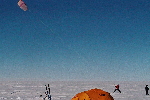
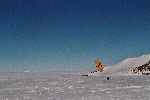
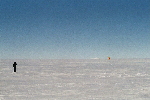
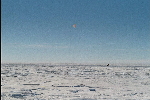
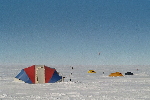
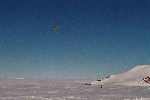
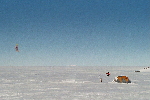



Somewhere nearby, the 'Last Degree' group was doing their training and preparation.
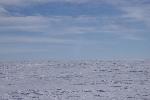
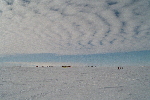
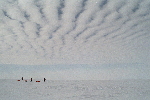
Nice day, even though it was spent mostly in camp. But no good news from the South Pole. Weather down south had been improving (a prediction mainly based on the "couldn't get worse" theorem), but not good enough and Thiel Mountains was still 'marginal'. But there was one bit of good news for that area. As an experiment, they had sent a Camoplast to Thiel Mountains. A Camoplast is a polar transport vehicle, similar to the Tucker. Until then, the fuel at Thiel Mountains had been brought there by air transport. Which meant a lot of cost to get the stuff there. (I think someone mentioned four barrels of fuel used to get a single barrel to Thiel Mountains. I'm not sure that this is actually true, or a misunderstanding. But let's assume that it's correct. Since the South Pole is about as far away from Thiel Mountains as Thiel Mountains is from Patriot Hills, this means that every barrel of fuel at the South Pole needs sixteen barrels of fuel in Patriot Hills (and getting fuel barrels to Patriot Hills isn't cheap to start with). Actually, Mike Sharp mentioned the actual cost per barrel at the Pole at some point, but I was too shocked to write it down and now I have forgotten...) So instead of airlifting the fuel to Thiel Mountains, putting a lot of barrels an two sledges and pull them there in an overland journey (takes about three to four days if you drive 24 hours a day) seemed like something worth trying. Turned out that it was a good idea. But there was an bonus to that: There were currently people at Thiel Mountains, who could observe the visibility, wind and temperature. So Jaco (weather guy) had not only the satellite images to work with, he also got 'on site' observations. Didn't make the weather any better, but at least we would know if it did.
Also, by then, someone had said the 'magic words'. The five of us going to the South Pole were getting a bit restless and worried. By now it was the 1st of January, we were not going to the South Pole that day and the Ilyushin was scheduled to be back on the 4th. Which only gave us two more chances (the 2nd and the 3rd) to get to the South Pole. And nobody had mentioned what would happen, if the Ilyushin came in and we hadn't south yet. While there was a general feeling "they won't do that, right?", the worst case scenario was that they just might tell us: "Sorry, that it didn't work out for you. Have a nice trip home.", put us on the plane and that would be it. (Which was a completely unjustified assumption and not at all the way things work down there, but worries and uncertainties started to creep up and spoil the mood.) But then Cherry said: "Don't you worry about that! You will go to the pole. They are very experience in making things happen. It will happen. Maybe not on schedule, but it will happen." After that, Antarctica turned into a place of perfect bliss. I wasn't worried about the schedule at all - as far as I was concerned, they might have told me that I would have to stay until the end of the season and I'd have been happy. The thing that had been worrying me was getting this close, but not any closer and blowing my one chance in life to get to the pole. Once it was clear that "it will happen", all worries were gone.
And on the very next day, it did happen.